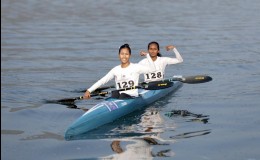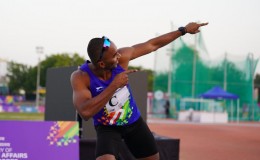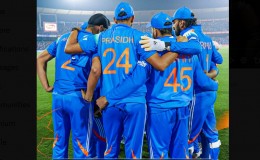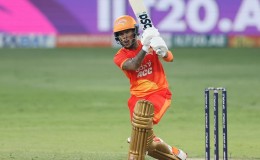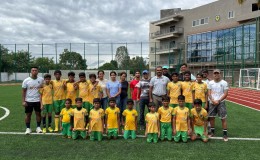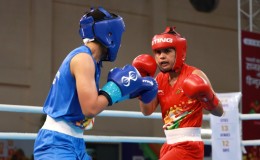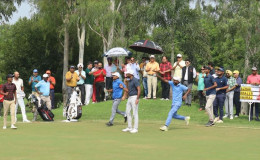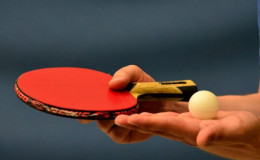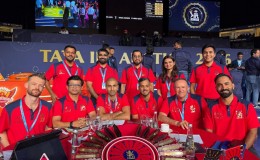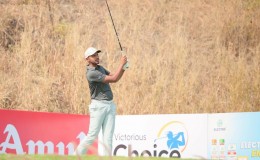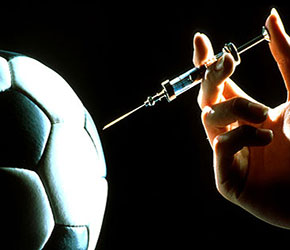 Even as the government, the Indian Olympic Association, Sports Authority of India and sports federations are red faced over the mess regarding the doping scandal that has hit the Indian sports (athletics in particular) off late, Indian coaches and sports experts from various sporting discipline are crying hoarse over the need to get more scientific.
Even as the government, the Indian Olympic Association, Sports Authority of India and sports federations are red faced over the mess regarding the doping scandal that has hit the Indian sports (athletics in particular) off late, Indian coaches and sports experts from various sporting discipline are crying hoarse over the need to get more scientific.
The world of sports has moved ahead with the help of science and technology. And here we are in India…we hardly know what sports medicine and sciences is all about.
Not long ago, the indifferent attitude adopted by the Sports Authority of India (SAI) had forced a number of its senior scientific officers and sports medicine doctors to resign from their jobs and if condition is to be assessed, it’s getting worse day by day.
“The situation has gone from bad to worse in the last few years. In 2006 nine out of the 25 sports medicine doctors and scientists had resigned in a span of one year. We all thought that it will be an eye-opener for the SAI. But it hardly made any difference. After a lot of hue and cry in the Parliament, ad-hoc arrangements were made but no concrete arrangements have been done to solve the problem. Rather, in theses three years, a number of doctors and scientists have retired and no step has been taken to fill the vacated seats,” said one sports medicine doctor on condition of anonymity.
"We don't have the concept of sports medicine and sciences in our country. Here the authorities think sports medicine and sciences are only meant to treat injuries. But that can be done by any practicing doctor. It's all about studying the athletes' behaviour, their progress, their requirements and finding the necessary solutions to improve their performance. It's not a day's job. To improve every team needs to have a support staff, including doctor, physiotherapist, masseur, psychologist, computer analyst, statistician, et al. But here we hardly have any," said a senior scientist, citing this as one of the vital reasons for India's dismal show.
Informing further about the apathy about Indian sports, he said that as if this is not enough, in any mega events the federations send support staff who are their favourites and from their own fraternity due to vested interests. "It's all about feathering their nest and obliging their near and dear ones who have brought them into power. And the government without much thinking clears their names. Hardly any of the support staff accompanying teams have any knowledge about sports medicine. So how can you expect them to help our sportspersons during these events," he questioned.

Most of the Indian contingent comprise of officials and not players! Interestingly, in case of selection of doctors, too, it is not merit that becomes the deciding factor. Doctors from SAI who remain attached for long periods with the teams during the domestic national camps usually find themselves replaced by others, who don't even know the athlete or the game, courtesy, the federation. As long as nepotism and favouritism remain, it will be very difficult for us to grow out of this and excel," argued a sports scientist, revealing that presently a number of physiotherapist and masseurs appointed by the federations and SAI are inadequately qualified.
“Every federation has appointed its set of staff and as usual it’s not the qualification but their proximity to the federation officials that has landed them the job. SAI too has appointed physiotherapist and masseurs for every federation and that in a way leads to a clash of interest. I have come across a number of masseurs and physiotherapists who are not qualified. I was surprised to know that one of them was a groundsman's son and other worked as a helper for a coach. And this is just tip of the iceberg and they get paid anything between Rs 10000 to Rs 15000. Even the psychologists appointed by the federations and SAI on adhoc basis are fresh pass-outs (mostly MA). In sports you need experienced psychologists with knowledge in sports or else the very concept of having one will backfire,” he informed.
One of the experts challenged the system and informed that these people who get the plump assignments hardly visit the national championships and camps. "How can you think of improving the conditions of athletes when they hardly study them? It can't be done in a day. The sportspersons need adequate and long term monitoring where each and every of their habits, including mental and physical, needs to be studied. Our country is already in dire crisis in terms of sports medicine practitioners and scientists. And whatever resources we have, they are not being utilised due to vested interests. So why only blame the athletes for the poor show when the problem lies somewhere else," he said, stating that a sportsperson can reach only to a level after which it is all about scientific training and analysis of his mental and physical being.
"We can never progress with this knowledge or the lack of it. The condition will remain the same. Developing infrastructure can facilitate an athlete's progress but cannot take him to that optimum level where they can compete with the very best in the world. Government will have to think on this. Presently, we don't have a single Sports Medicine and Sciences department run by any state government. Even if not elaborate, it will have to be made mandatory thing for every state government. It's the need of the hour where sportspersons have to be monitored from the very initial stage. China is an example and see its progress," he voiced assertively.
"The Australian Institute of Sports Medicine (Canberra) boasts of approximately 80 to 90 member staff at scientists' level while the Chinese Institute of Sports Medicine ( Beijing) has 170 and the Japan Institute of Sports Medicine (Tokyo) has approx 150 staff at one very centre compared to 15 spread at all centres in India. And here we don't have even a psychologist at some centres. So the existing condition of sports scenario in our country should not come as a big surprise," said an expert.
INFOGRAPHICS:
Number of Staff present at different centres
• Physiotherapists and masseurs all adhoc basis (under matriculates working as masseurs/masseuse)
• Patiala—One Sports Medicine Doctor + One Psychologist (contract basis) + One Nutritionist (contract basis) + one anthropometry + one biomechanicist (looking after the engineering section) + one biochemist (on contract).
• Bangalore—One Sports Medicine Doctor + One Physiologist + Two Bio-mechanist + One Nutritionist.
• Delhi—One Senior Scientist in anthropometry (working in the administration) + no lab.
• Shilarro (HP) –SAI High Altitude centre no scientific set up + no doctor even.
• Sonepat: No scientists or any lab.
• Pune: One Sports Medicine Doctor + One physiologist (only at Army Sports Institute) +one invited from Cuba lately in Sports Medicine
• Balewadi:- Ad-hoc arrangement only for doctor + no lab + no scientists.
• Bhopal: No scientific set up.
• Lucknow: No scientific set-up.
• Chennai: (squash) no scientific set up.
• Hyderabad : (Badminton and rowing camps): No scientist + no lab.
• Gandhinagar—0(senior scientist) + 0 (sports medicine doctor).
• Kolkata—Four (One physiology+ one psychologist+ Two sports medicine doctors)
• No video analyst in SAI which is an important tool in modern competitive sports.
• No Orthotics expert + No podiatry expert anywhere in SAI
The aggrieved who have resigned in last four-and-a-half years:
Dr Jolly Roy (psychologist)—Bangalore—now with Malaysian Sports Council
Saju ios5eph (physical trainer)—Kolkata —now with Malaysian Sports Council
Dr Ashok Gosh (Patiala)—Physiologist- worked as professor in Kualalumpur, Malaysia till recently
Dr GL Khanna (Patiala)—Senior Scientific Officer-Working in college Faridabad
Dr Suman Mukhopadhyay (Patiala)—Physiologist—now working as Assistant. Professor, at National Institute of Industrial Engineering (NITIE),
Dr Preeti Rishi Lal (Patiala)—nutrition--now working as professor in LSR College, Delhi
Dr Sanjeev Sahni (Patiala)—Psychologist—working as Consultant Naveen Jindal Group
Dr Pratima Rajan (Gandhinagar)—Sports Medicine-working in Mumbai
Dr Rajeev Ahuja (Bangalore)—Sports Medicine-working as practicing sports Physician in Australia
Dr Asis Goswami Kolkatta – exercise physiologist –working as consultant with corporate houses in Kolkutta
Dr P. k. Ramesh Patiala –Sports Medicine-Practicing sports physician in Bangalore
Dr S. k Sinha Kolkatta GTMT –Joined university as Associate professor
Dr S. K Nandi –Patiala – (Sports Medicine)-absent for the last five years-fighting legal battle with SAI
• The retired
Dr Sebastian (Bangalore)
Dr Vimla Bhatia (Patiala)
Dr C.S. Jayaparkash (Bangalore)
Dr Ashok Ahuja (Patiala)
Dr PSM Chandran (Delhi)
• Full Fledged Faculty of Sports Sciences was formed at NIS, Patiala in 1982 with 45 rooms. And now they just have three people to run it • SAI counts GTMT (General Theory and Methodist and Training) as part of sports science experts, but it exist no where in the world now. Basically they are all Mped and physical education trainers. • Comparison: The Australian Institute of Sports Medicine (Canberra) boasts of approximately 80 to 90 member staff at scientists' level
• The Chinese Institute of Sports Medicine ( Beijing) has 170
• The Japan Institute of Sports Medicine (Tokyo) has approx 150 staff at one centre
UNDERSTANDING THE SCIENCE OF SPORTS
Indian athletes tend stagnate after a certain level. For example, top Indian 100 meter sprinters have been clocking timing in the range of 10.33-10.36 seconds the past 4-5 years. It's not as if they are not capable of improving. The question is how? To improve in a fair manner – without resorting to doping -- physiology, anthropometry, biomechanics, psychology and nutrition comes into effect. That's where sports sciences expert steps in with well defined area of operation.
Physiologist: A specialist who studies the biological functions of living organisms and their parts. An exercise physiologist uses this knowledge to cause an enhancement of performance of the athlete in the field, apart from formulating a training programme on scientific lines based on the actual precise potential of the athlete, as well as regular scientific monitoring of training.
Psychologist: A person trained and educated to perform psychological research, testing, and therapy. Asports psychologist uses his acumen to motivate the athlete to bring out his best. If an athlete can really believe that he can do it, the battle is already half won! Further, the sports psychologist assesses the personality traits of each sports persons and offer mental as well as psychological training to optimise their performance.
Anthropometrist:
A specialist who studies the measurement of the size and proportions of the human body for use in anthropological classification and comparison. A sports anthropometrist primarily uses his knowledge, in collaboration with those of the exercise physiologist and sports biomechanist to ascertain the mobility of various joints and optimize their coordinated movement, ascertain the body type of the athlete, formulate weight loss strategies, in consultation with the sports nutritionist and exercise physiologist.
Bio-chemist: A specialist who studies the chemical substances and vital processes occurring in living organisms; biological chemistry; physiological chemistry. A sports biochemist dwells on the transient as well as the long term effects of exercise on the biochemical transients of the body and plays a crucial role in the scientific monitoring of training.
Bio-mechanist: A specialist who studies the action of external and internal forces on the living body, esp.on the skeletal system. A sports biomechanist uses his understanding in discerning the movement of the different body parts as well as the entire body, during sports performance, particularly relevant in sprints, jumps, throws and lifts. The various angles the body (parts) make during take off or throw(s), play a critical role in performance. Technique correction is also a major part in exercise biomechanist.
Nutritionist: A person who is trained or expert in the science of nutrition. A Sports nutritionist is a scientist who assesses the nutritional status as well as the nutritional requirement of the sports persons, based on the enormity of the training load. Computation of the energy expenditure profile (to estimate the amount of energy a sports person(s) burns, during training), is also a very critical.
Sports Medicine Doctors: A physician with specialized training who promotes lifelong fitness andwellness and encourages prevention of illness and injury. A sports medicine doctor monitors the medical aspects of sports training, ensures that overtraining doesn't occur, and so, is more proactive in the field than being reactive (treating injuries once they occur). Of course, treatment and management of an injury or a disorder also forms the part and parcel of sports medicine.
Ironically, although the National Institute of Sports at Patiala, has been conducting a two year Diploma Course in Sports Medicine (DSM), the only sports medicine diploma recognised by the Indian Medical Council and affiliated to the Baba Farid University of Health Sciences, Faridkot, Punjab (and more than 75 medical graduates have successfully completed their post graduate diploma in sports medicine), yet, none of the SAI doctors recognised post graduate degree or a diploma in sportsmedicine! All present medical doctors in SAI are plain M.B.B.S. degree holders.
SOME FACTS
• Sports Authority of India in the post 1982 Asian Games phase employed about 60 sports scientists, including doctors, to provide scientific inputs to Indian sports. But post 1992 the government put a blanket ban on further recruitment post, with no avenues for professional growth. Even as the rest of the world is embracing science and technology in sports, India has moved in the reverse direction.
• Department of Sports Sciences at NIS, Patiala came into existence in 1982 with 45 rooms. Currently they have just three people to occupy them.
• SAI counts GTMT (General Theory and Methodist and Training) as part of sports science experts, but it exist no where in the world now. Basically they are physical education trainers.
SOME OF THE ROOT CAUSES
Lets' get to try and attempt to find out the root cause(s). Let us start with the coach. Everyone believes that the centre of focus in sports is the athlete and the coach. But in reality the Indian coach is a haggard lot. Let's see why: Firstly, lets say coach "A" is training athlete 'Y' for five years, during his/her formative years. Athlete 'Y' excels in the Nationals and is called to the National camp and handed over to Coach "B". The training strategies of Coach "A" and "B" not only need not be dissimilar but could be conflicting. The athlete, 'Y' is perplexed. The training goes on till the end of the camp. Athlete 'Y' now goes back to coach "A". This shuffling continues till the team is announced for a major international competition where the athlete 'Y' finds that he/she is selected in the team but to his/her dismay neither coach "A" or "B are accompanying, but that the federation has named coach 'Z' as a part of the team. And you expect the athlete to perform despite this?
Secondly, often along with coaches "A, B and Z" we find coach "alpha" or "beta" or "gamma" 'supervising' the training of the coaching of athlete 'Y' by the coaches "B" or "Z". This is the 'foreign coach syndrome' and most Indian athletes and coaches are wary of it (excepting in some disciplines like shooting). Foreign coaches, often with dubious credentials walk in the Indian sports arena with aplomb, getting salaries more than 2000 US$ per month, against the paltry salary that an Indian coach enjoys. How utterly unfair is our system!
As far as equipment is concerned, we never can afford to have the best of the lot. A world class racing cycle can cost up to a hundred thousand US dollars. Similarly, archery, shooting etc. can be prohibitively expensive. And our country has the dubious distinction of being quite high in the list of corrupt nations, need we say more? Often we end up paying more for substandard equipment, our grounds decorated with Astroturf that is poorly laid, shoes that come in a size either too big or too small!
The training (and competition) calendar lacks objectivity and far sight, often left to the whims and fancies of federation people, who, with all due respect, in most of the cases, have never played the game themselves.
By Rakesh Jha
Indian Sports News

